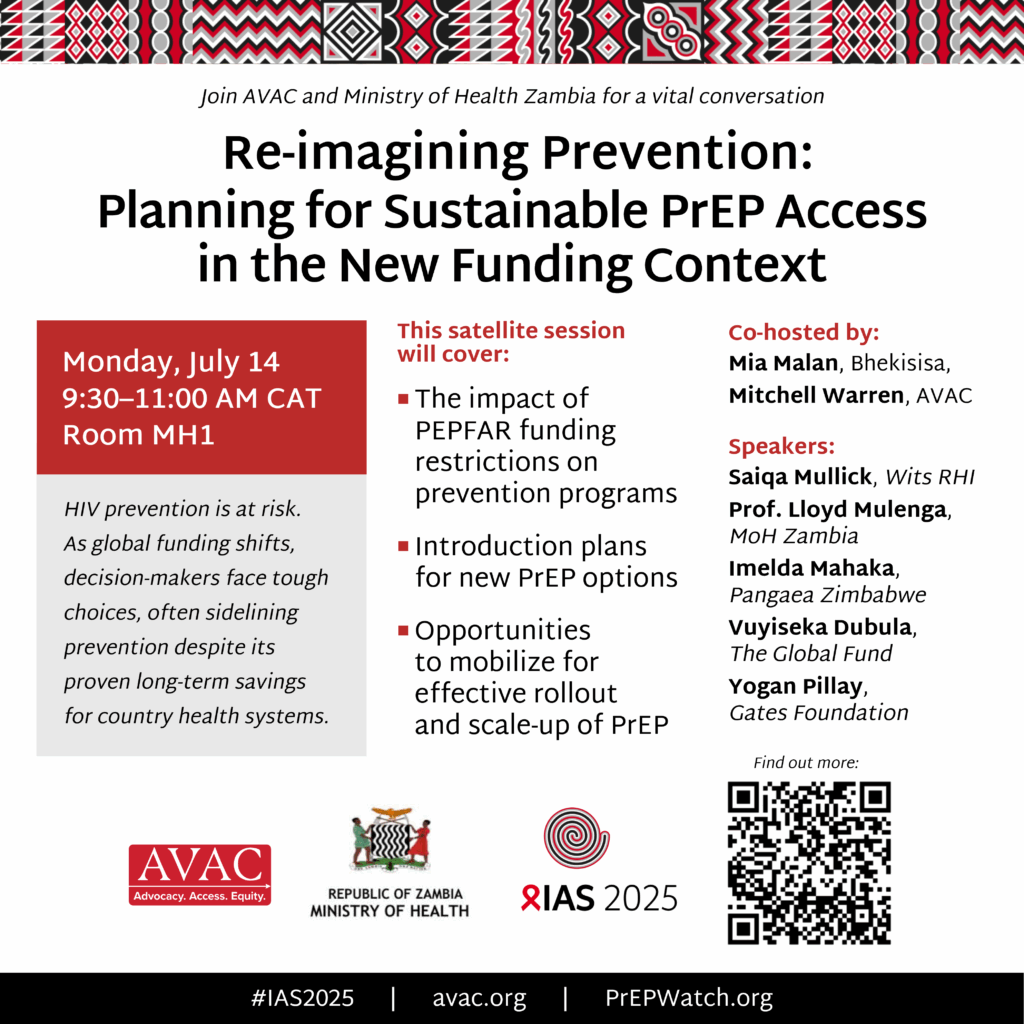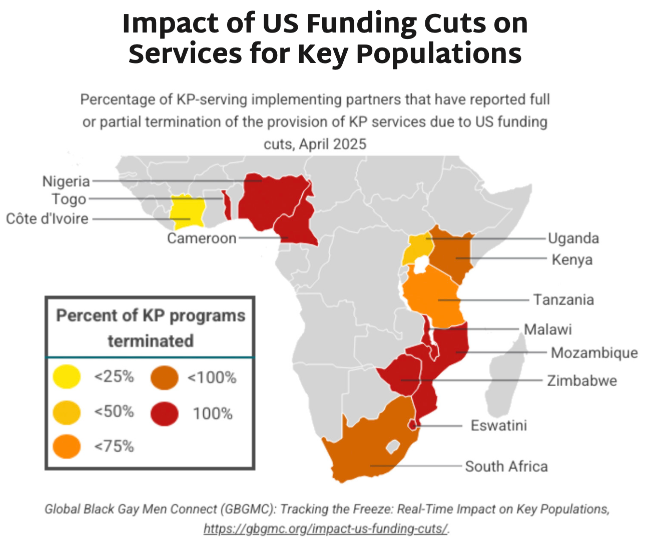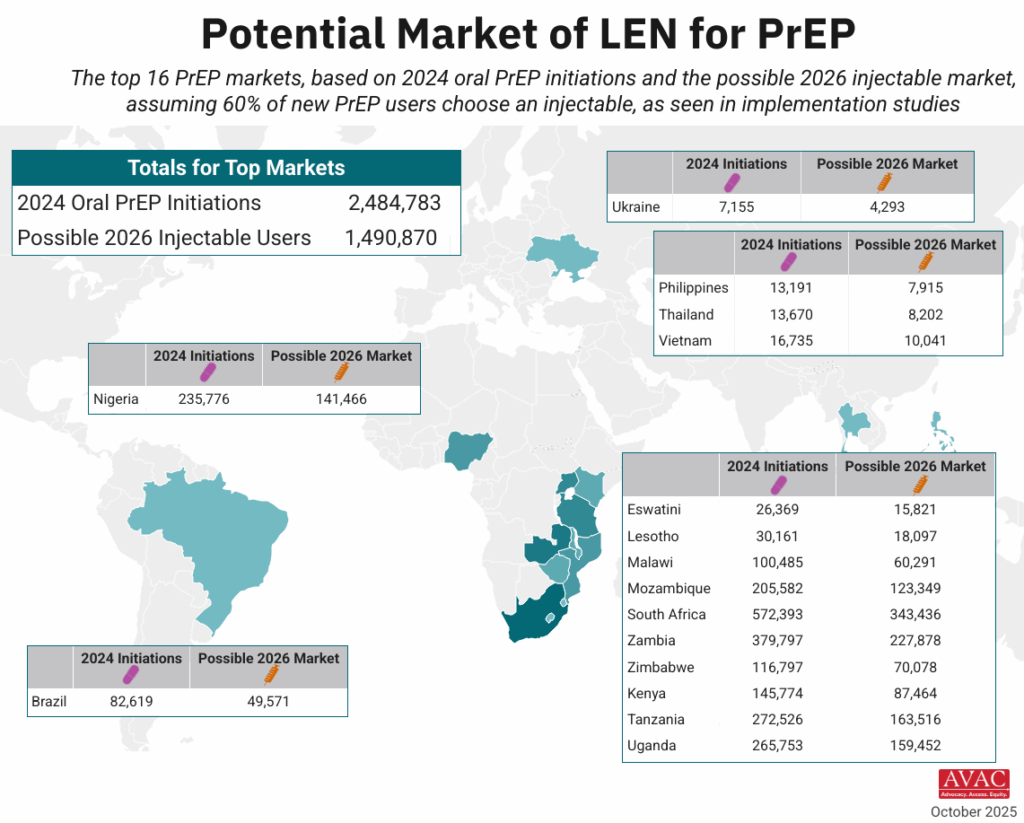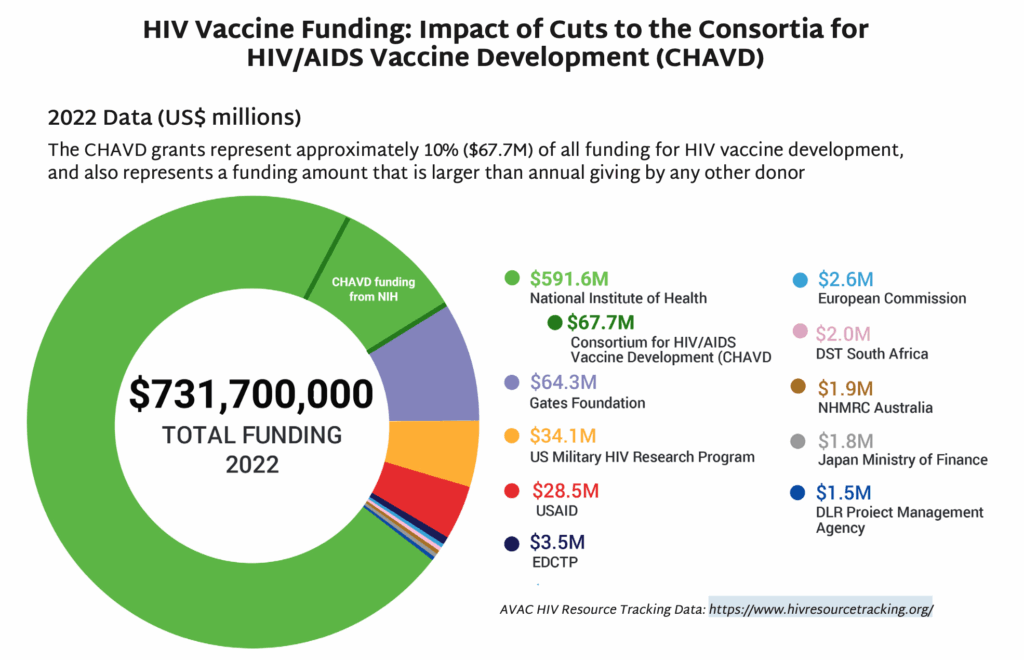If you are attending the International AIDS Society Conference (IAS), be sure to join AVAC and the Ministry of Health, Zambia for this vital conversation.

Avac Event
If you are attending the International AIDS Society Conference (IAS), be sure to join AVAC and the Ministry of Health, Zambia for this vital conversation.

With the recent FDA approval of injectable lenacapavir (LEN) for PrEP and the drastic withdrawal of US investment in HIV prevention, the field must reimagine and recommit to getting PrEP rollout right this time AND to sustaining the HIV research pipeline. Research on HIV has brought numerous advances to global health, but controlling, and ultimately ending, the epidemic depends on continued investment in innovation.
This issue of PxWire looks at the scale of shuttered prevention programs for key populations (KPs), the potential market for injectable LEN, and the devastating cuts to research for an HIV vaccine.
Read below or download the PDF version of this issue.
The PEPFAR stop work orders issued by the US government in January 2025 have devastated the HIV response worldwide, including funding for primary prevention. Sustaining the HIV response and bending the curve of incidence depends on identifying new sources of funding to maintain HIV prevention programs for KPs.

Stakeholders—including Global Fund, PEPFAR, WHO, UNAIDS, Unitaid, Ministries of Health, advocates and implementing partners—have critical work to do now to ensure doses of LEN hit the ground as quickly as possible. Check out Gears of Lenacapavir for PrEP Rollout and Getting PrEP Rollout Right This Time to get the details.


AVAC develops a wide range of resources to inform decision making and action. Check out the latest:
The top 16 PrEP markets, based on 2024 oral PrEP initiations and the possible 2026 injectable market, assuming 60% of new PrEP users choose an injectable, as seen in implementation studies.
Press Release
Contact: [email protected]
New York, NY, June 27, 2025 — AVAC welcomes today’s ruling affirming the constitutionality of the Affordable Care Act’s preventive services mandate, including coverage for HIV pre-exposure prophylaxis (PrEP) at no cost to patients. This decision represents a critical victory for public health, health equity, and the millions of people who rely on preventive services to stay healthy and safe. By rejecting efforts to strip away access to PrEP and other essential services based on ideological objections, the court has reaffirmed that public policy must be grounded in science, not stigma.
Since the original Braidwood decision, AVAC and our partners have worked tirelessly to raise awareness of the case’s far-reaching implications. We joined legal advocates, public health experts, and community leaders to underscore what was at stake: access to evidence-based care and decades of progress in preventing HIV and other serious conditions. Today’s ruling confirms the power of coordinated advocacy and the importance of protecting science-driven health policy from politically motivated attacks.
This outcome ensures that individuals can continue to access PrEP, both the medication and the clinical services necessary to support its use, without cost barriers. It preserves critical public health gains and sends a strong message that discrimination has no place in our health care system.
“This ruling is a relief in maintaining the critical role under the Affordable Care Act to cover preventive care services, including HIV pre-exposure prophylaxis (PrEP),” said Mitchell Warren, AVAC’s Executive Director. “Preventive services across healthcare are cost-saving and life-saving, and I am grateful that the Supreme Court found on the side of evidence, logic, public health, and human rights. There has been enormous progress in the fight to end the HIV epidemic, and just last week the FDA approved the newest form of PrEP, injectable lenacapavir. Lenacapavir can be a transformative option, but only if it is available to people who want and need it, and today’s ruling can make that possible.”
Looking ahead, AVAC will continue working to ensure that PrEP access is not only protected but meaningfully expanded, particularly for the communities that have long faced systemic barriers to care. This includes advocating for a national PrEP program, strengthening provider and patient education, supporting implementation by community-led organizations, and holding insurers accountable for compliance. Today’s ruling offers a strong foundation to build from, and we remain committed to a future where HIV prevention is accessible, equitable, and fully resourced for all.
Today’s Supreme Court decision does confirm enormous power with the Secretary of Health and Human Services, which under the current administration is cause for significant concern. “In the midst of today’s victory, we must be tempered by what has happened with the CDC’s Advisory Committee on Immunization Practices (ACIP), as it could be a harbinger of what a Secretary of HHS can do to twist committees and task forces that should be composed of technical experts guided by science to ones that are guided by ideology, illogic and political whim,” said Warren.
###
About AVAC: Founded in 1995, AVAC is an international non-profit organization that provides an independent voice and leverages global partnerships to accelerate ethical development and equitable delivery of effective HIV prevention options, as part of a comprehensive and integrated pathway to global health equity. Follow AVAC on Bluesky and Instagram. Find more at www.avac.org and www.prepwatch.org.
It’s been 22 weeks since the US president issued the executive orders that began the chaotic dismantling of USAID. See recent, remarkable, and much-needed New York Times coverage on the destruction of USAID. And check out this new episode of the This American Life podcast on the aftermath of shutting down USAID.
We at AVAC took a public stand against this attack on global health and development in our court case, AVAC v. United States Department of State, filed by Public Citizen on February 10. We took this step because we understood the devastation that would come from such drastic and sudden divestment in the HIV response and global health. We also believe it was illegal and unethical.
In March, US District Court Judge Amir Ali ruled the foreign aid freeze was, indeed, unlawful, and that the administration had “usurped” the authority of Congress. Since that time, some 400 grants have been restored and the government is slowly complying with the Judge’s order to pay all invoices for work conducted through February 13. It’s a mere fraction of USAID’s former self, but each of these restored programs and payments represent an attempt to make America and the world stronger, safer and more prosperous. Just as important, our court case, along with a related one brought by the Global Health Council and colleagues, has forced into the public record the administration’s cynical maneuvers to dismantle global health; information that empowers advocates to fight and, we hope, finally spurs Congress to do its job.
“We cannot cede ground gained against HIV and other global health threats out of fear or paralysis in the face of these reckless actions. It is imperative to hold this administration responsible. And it’s imperative to invest in global health and sustain the gains in HIV. Global health advocates know this better than anyone, and we are fighting back,” said AVAC Executive Director, Mitchell Warren.

Watch AVAC’s Executive Director, Mitchell Warren’s video explaining how this court case is one of many critical steps to safeguard global health and the HIV response.
Nowhere is that fight to safeguard and advance HIV prevention more important than work to rollout injectable lenacapavir (LEN) for PrEP, just approved by the US Food and Drug Administration. LEN approval signals what could be a turning point in the epidemic – but only if the field invests in bold, strategic action.
“The science is remarkable, and the FDA approval is in. But it’s what happens next that makes the science count. It’s whether or not the technology is made available and becomes truly accessible that will bring impact. Will the world get it right this time? Because for 15 years we’ve squandered the potential of PrEP. That hope depends on fierce and effective advocacy,” said Warren.
HIV prevention advocates around the world are demanding and preparing for injectable LEN to reach the communities that need it most with speed, scale and equity. Watch this video for more on status of LEN rollout and advocacy priorities.
“Scientific progress has been made over the years, and we celebrate them, but without truly having a prevention story to tell…yet. Now it’s time for that story to be told,” said APHA Executive Director Yvette Raphael.
Read this report from Friends of the Global Fight Against AIDS, Tuberculosis and Malaria, Principles of a responsible transition of American leadership to end AIDS: Strategic transition or pandemic resurgence?, on how PEPFAR and US leadership can play an instrumental role in reaching epidemic control.
“There’s much work advocates are doing, and much work ahead. Some donors have come forward, but it’s only a start. We also need to advocate with regulatory authorities at the country level, not to mention pushing for an affordable price, and a big enough supply from Gilead now to support demand creation at scale in order to build a sustainable market, which in turn will support generics and further reductions in price. Advocates are now and will continue to be fighting at the country level and the global level to move all this forward,” said HEPS Uganda Executive Director Kenneth Mwehonge and co-chair of the Civil Society Caucus of the Coalition to Accelerate Access to Long-Acting PrEP.
Check out the Caucus statement on priorities for LEN rollout, and these resources to support our collective advocacy:
Recent news headlines, including the just published New Yorker magazine article by Science reporter Jon Cohen, capture the power of this moment to reshape the HIV response and finally control the epidemic. As advocates, we know the stakes very well.

“What all of us working together have tried to do for years and years and years, is to overcome the barriers from stigma to disinformation, that we’ve seen with oral PrEP, and with treatment 20 years ago. It will take Gilead, working with all of us advocates, to collectively ensure that this drug is accessible to all, so that the success depends not on the politics but on the product. We have to hold everyone, including ourselves, to account for keeping on task and for making sure that we do not squander this opportunity. So, let’s do this together and lay the groundwork for all future innovations to go faster, with speed, with scale and with equity for all,” Warren said.
The field is at a major inflection point, punctuated by both political challenges and scientific opportunity – and we can’t let the former overtake the latter.
This wide-ranging slide deck gives a complete overview of lenacapavir — showing the overall prevention product pipeline, describes lenacapavir, compares it to other options, discusses the trials testing the product, next steps, and links to advocacy resources.
The timeline for generic LEN for PrEP to come to market is expected to be significantly shorter than for CAB for PrEP. Bioequivalence (BE) testing for LEN, which demonstrates a generic product works in the body in the same way as the originator product, is likely to be six months, vs. the 18 months for CAB for PrEP, because of differences in the drug formulation. The rapid granting of voluntary licensing by Gilead also contributes to this shorter timeline. For the latest on LEN, visit here.
This market assessment supports countries, donors, implementing partners, and advocates in making informed decisions about the introduction, scale-up, and equitable delivery of long-acting PrEP among key populations and other priority groups.
Press Release
Contact: [email protected]
New York, NY, June 18, 2025 — AVAC welcomes the U.S. Food and Drug Administration (FDA) approval of injectable lenacapavir (LEN) for the prevention of HIV as pre-exposure prophylaxis (PrEP). LEN, developed by Gilead Sciences, is a twice-yearly injectable PrEP option that showed nearly complete protection against HIV in the landmark PURPOSE 1 and 2 trials. Science Magazine named LEN the “Breakthrough of the Year” in 2024, a recognition that reflects its enormous potential. But that promise will only be realized if it is rolled out with speed, scale, and equity.
“The approval of LEN is a much-needed boost for HIV prevention, given the strength of the science and the simultaneous disruption in HIV programs globally,” said Mitchell Warren, executive director of AVAC. “But US FDA approval is just one in a series of steps needed to ensure that injectable LEN can help reduce the 1.3 million new HIV infections that occur each year. Scientific progress only matters if innovation actually reaches people. LEN for PrEP is poised to re-shape the HIV response, but only if today’s approval is accompanied by bold, strategic, effective and equitable rollout that reaches the populations that need access. Otherwise, the world risks squandering this PrEP opportunity, as it has with other PrEP options too often over the past 12 years.”
In December, PEPFAR and the Global Fund announced a coordinated ambition to reach two million people within three years of product launch. This commitment signals an unprecedented opportunity to make PrEP access a reality. But translating this ambition into impact, especially now amid the current political environment, is not without considerable challenges.
“Political will, programmatic implementation, and sustainable funding are needed to truly accelerate equitable and impactful introduction of LEN worldwide,” said Wawira Nyagah, AVAC’s director of product introduction & access. “We have over a decade of hard-won lessons on what it takes to rollout PrEP effectively, and the field cannot afford the delays we have seen with the past launches of daily oral PrEP, the monthly dapivirine vaginal ring (DVR), and every-two-month injectable cabotegravir (CAB). Lives depend on speed, scale and equity.”
The World Health Organization (WHO) is expected to release updated PrEP guidelines for LEN in July, and regulatory agencies in Brazil, Europe and South Africa are simultaneously reviewing the product. But the current political context, including a shuttered USAID and further disruptions across global health, demands an urgent and courageous response. In January, the US Administration issued a stop-work on all USAID-funded grants, nearly paralyzing HIV treatment and prevention by PEPFAR, the primary funder of programs in HIV-burdened countries (and administered by USAID). In February, PrEP was broadly excluded from a waiver that allowed HIV treatment to continue and allowed PrEP only for pregnant and breastfeeding women. These policies could not only undercut LEN’s promise but roll back years of progress in HIV prevention.
It will take new, re-vitalized and committed partnerships to work together to sustain past progress and advance HIV prevention to deliver on the UN targets for epidemic control. AVAC’s The Gears of Lenacapavir for PrEP Rollout outlines the steps needed from national governments, funders, researchers, drug-makers including generic manufacturers, and civil society to ensure LEN reaches those who need it most. In the near term, these stakeholders each have vital work to do to complement the initial announcement from the Global Fund and The Children’s Investment Fund Foundation (CIFF) in their pledged collaboration to significantly expand access to LEN for PrEP.
“No one donor, national government or manufacturer can realize this ambition alone,” said Warren. “All stakeholders—including Gilead, PEPFAR, and the Gates Foundation—must act decisively to seize this opportunity, ensuring that all populations—regardless of geography, income, or identity—benefit from this innovative prevention option.”
Meeting this moment requires funders, Ministries of Health, implementers and civil society partners to collaboratively design a comprehensive introduction strategy that breaks the sequential nature of traditional approaches to scaling up interventions. Instead, to speed up introduction, stakeholders must move toward a parallel approach where research, implementation science, and programs at scale are designed, funded and implemented simultaneously. This introduction strategy should entail:
“This is the moment to build on the momentum of science, which has brought the field to this day, when LEN for PrEP is speeding through regulatory review faster than any prevention product to date,” said Nyagah. “Translating this success into real impact on the epidemic, led by communities around the world, must be a top priority among all stakeholders.”
###
About AVAC: Founded in 1995, AVAC is an international non-profit organization that provides an independent voice and leverages global partnerships to accelerate ethical development and equitable delivery of effective HIV prevention options, as part of a comprehensive and integrated pathway to global health equity. Follow AVAC on Bluesky and Instagram. Find more at www.avac.org and www.prepwatch.org.
On June 11, AVAC hosted a conversation, The Scientific Journey of Lenacapavir: From basic science to clinical development to impact, to explore how US support from NIH for basic science and South Africa’s clinical research infrastructure made possible the development of lenacapavir for PrEP (LEN), a discovery in HIV prevention that went on to be named Science magazine’s 2024 Breakthrough of the Year.
As the field anticipates initial regulatory approval from the US FDA by June 19 and a WHO recommendation in July, Linda-Gail Bekker of the Desmond Tutu Health Foundation, Wes Sundquist of the University of Utah and Mitchell Warren of AVAC underscored how this moment of promise is threatened by sweeping attacks on science, research and the very systems that made the development of LEN possible.